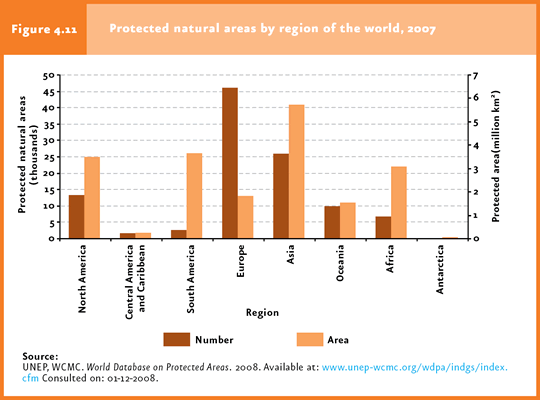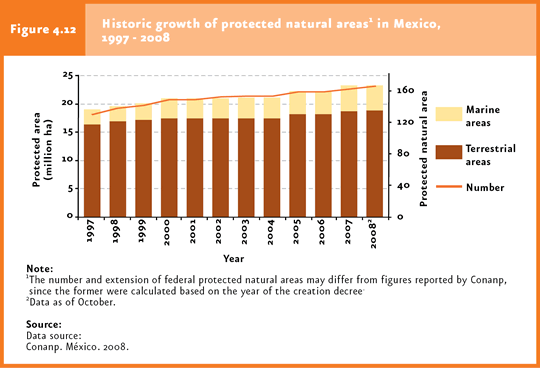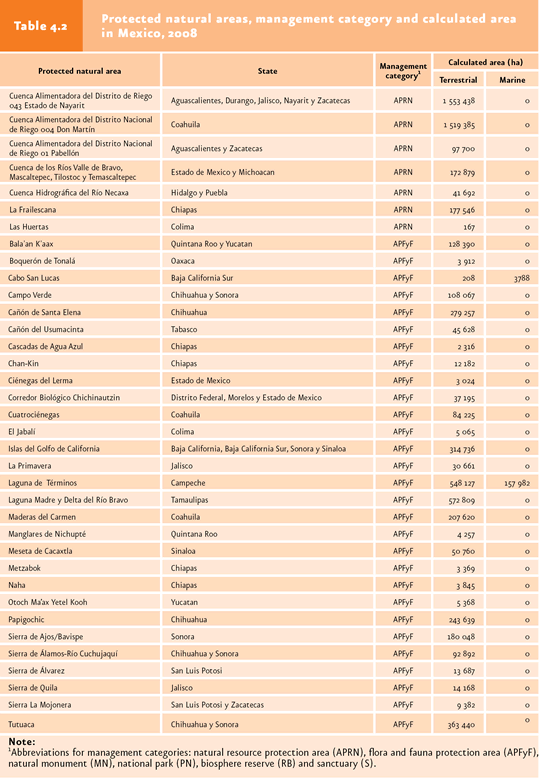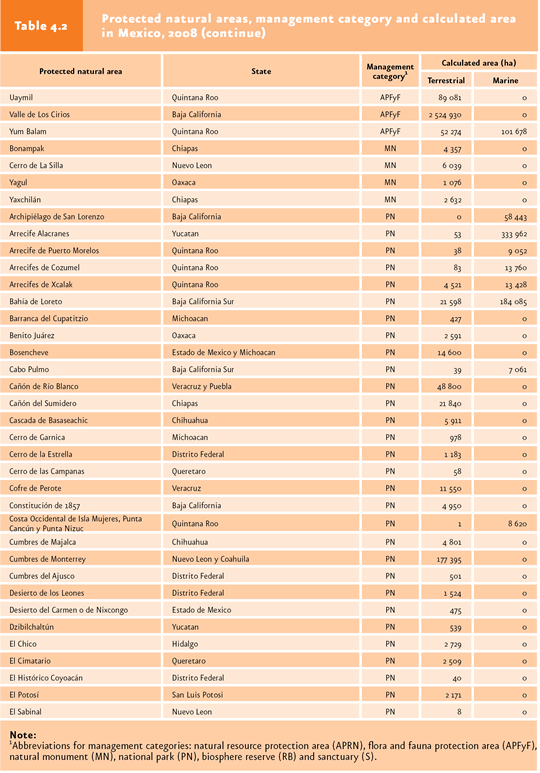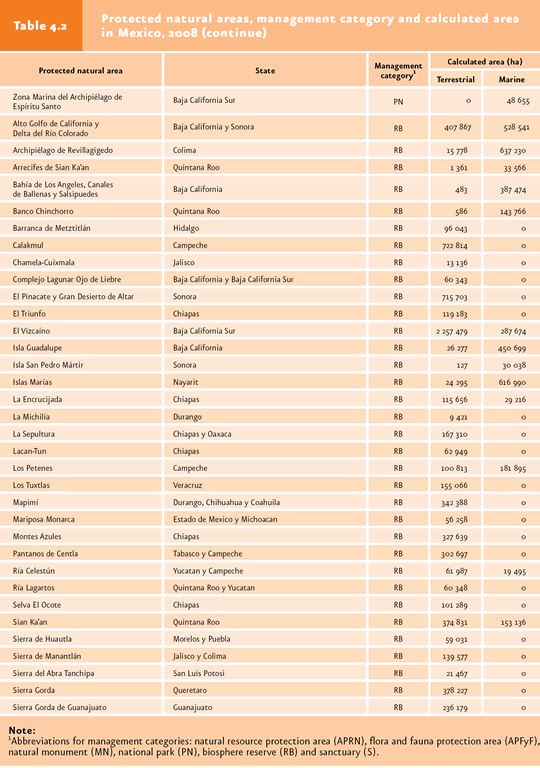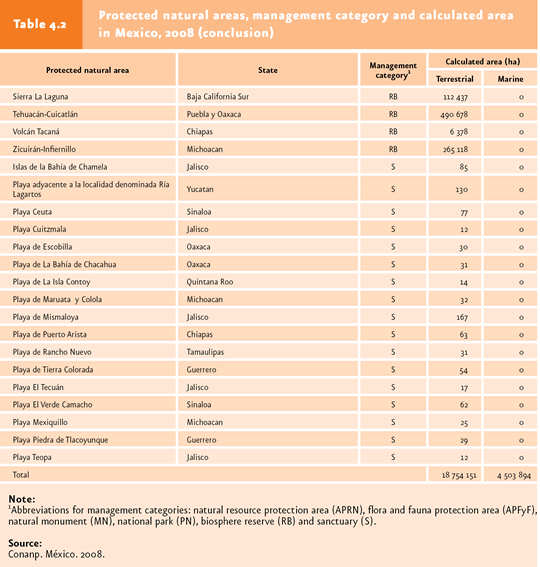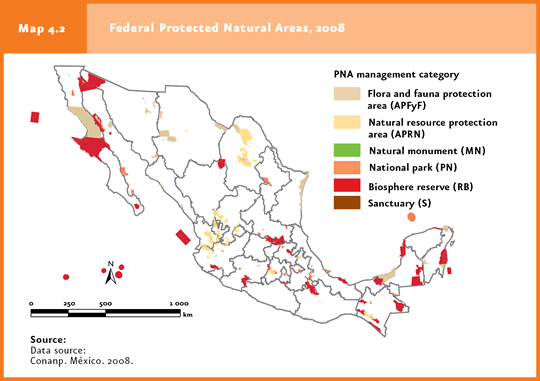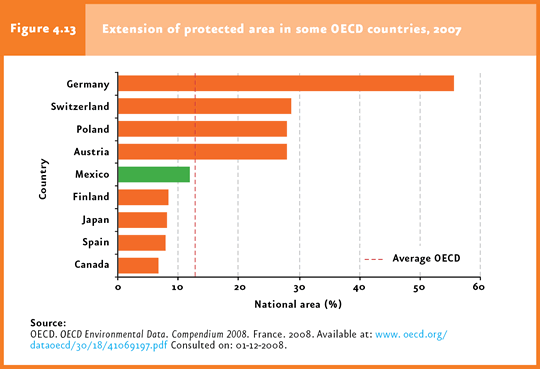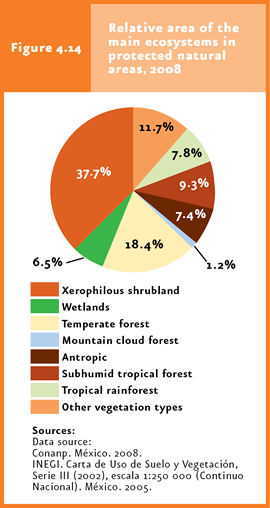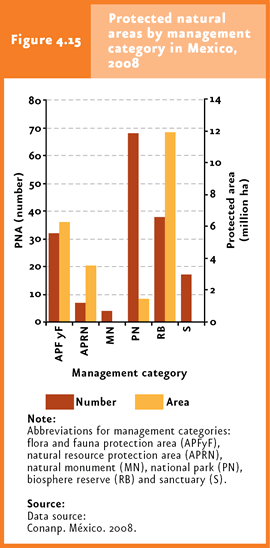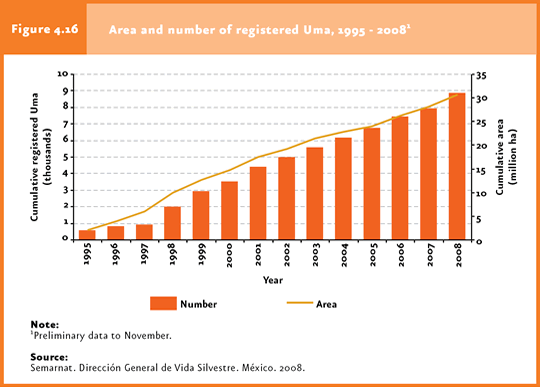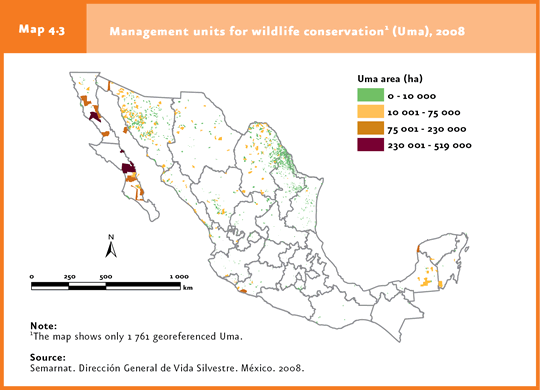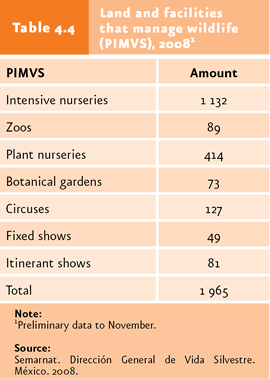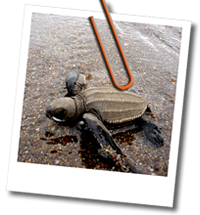
By October 2008, Mexico had 166 ANPs which covered approximately 23.3 million hectares (11.9% of the country’s terrestrial area). |
As of November 2008, 8,859 Umas have been registered, covering 30.9 million hectares (15.7% of the national terrestrial area). |
| CHAPTER 4. BIODIVERSITY |
In view of the loss of area covered by natural ecosystems and of species living in them, several strategies have been implemented both in Mexico and worldwide aiming at reducing the stresses that threaten them, mitigating their effects and offsetting the deterioration. These strategies have been oriented mostly to two biodiversity levels: species and ecosystems. Even when efforts have been focused on preserving the genetic richness of the population of some species (mostly those domesticated species important as food or in trade), these have been highly specific. In the case of actions implemented for the conservation or recovery of species of particular interest, the development of the Program to Recover Priority Species (PREP in Spanish) is worth mentioning. Given the enormous challenge involved in preserving the high number of Mexican animal and plant species, and given the difficulty of having individualized programs for each, the 1997-2000 Program for Wildlife Conservation and Production Diversification in the Rural Sector proposed a number of projects for several plants and animals that, according to the specialists’ judgement, should be deemed high-priority species. As of the year 2008, a total of 14 programs had been developed for several groups and species (Table 4.1).
In the year 2008, under CONANP’s guidance, the Program for the Conservation of Priority Species was initiated, aiming at protecting the endangered Mexican species, particularly those included in the IUCN’s Red List of Threatened Species, plus other species which are emblematic of our country’s culture. Furthermore, and aiming to protect the marine turtle species nesting in Mexican beaches, the National Program for Marine Turtle Protection Conservation Research and Management, currently under CONANP’s responsibility, coordinates 27 Centers for Marine Turtle and the Mexican Turtle Center located in the 13 Mexican costal states (refer to Box The mexican sea turtles). Two main strategies have been adopted to preserve ecosystems. On the one hand, efforts have been made in matters of ecosystem integrity and environmental service preservation (specifically through the creation to Protected Natural Areas and Pay-Per-Environmental-Service Programs), and on the other, efforts focused on the sustainable use of biodiversity (e. g. the System of Management Units for Wildlife Conservation, SUMA in Spanish) which, indirectly, preserve ecosystems where target species live. The latter also includes programs implemented by other sectors (mostly forestal) which promote the rational use of forest biodiversity, including the Forest Development Program (PRODEFOR in Spanish) and the Forest Resource Sustainable Management and Conservation Project (PROCYMAF in Spanish). For further information on this and other programs, please refer to the Terrestrial Ecosystems chapter.
Protected Natural Areas At a global level, the creation of Protected Natural Areas (ANP in Spanish) has been the main conservation strategy in response to the destruction of natural ecosystems since the past century. These are either terrestrial or aquatic (inland or marine) areas representative of a number of ecosystems, where the original environment has not been significantly altered as a result of human activity, and which, provide several types of environmental services, even hosting important natural resources or species of ecological, economic and/or cultural importance. Over the world, the growth in the number of and area covered by ANPs has been highly significant over the past decades. By 1972, 3,392 sites had been declared as ANPs, including an area of 2.78 millions square kilometers; by 2007, the number of ANPs rose to 107,034, amounting to 19.6 million square kilometers (UNEP, 2008). In 2007, the largest net ANP area was located in Asia (5.7 million km2, i.e., 29.2% of the total protected areas worldwide), followed by South America (3.6 million km2, 18.6%) and North America (3.5 million km2, 17.9%; Figure 4.11). The regions with the smallest ANP areas are Central America and the Caribbean (247,600 hectares, 1.27% of the total protected areas) and Antarctica (69,700 hectares, 0.35%).
In Mexico, the creation of ANPs has also been the most widely used conservation strategy at both federal and state levels. Today, CONANP is responsible for all activities carried out in the country´s federal ANPs. The formal incorporation of Mexico to the global national-park project started during President Venustiano Carranza´s term, through the decree to declare the “Desierto de los Leones” as the first National Park, in 1917 (Melo, 2002). Substantial efforts have been made over the past years to increase the number of protected areas in Mexico. In 1997, there were 130 areas encompassing a total of about 18.9 million hectares, i.e., 9.7% of national territory. By October 2008, there were 166 ANPs, representing approximately 23.3 million hectares of protected land, 18.7 million of which correspond to inland areas (about 80.6% of total protected areas) and a little over 4.5 million hectares to marine areas (19.4%; Figure 4.12; Table 4.2; Map 4.2; Cuadro D3 BIODIV04 12; IB 6.1-6, 6.3-10, 6.3.1-5, 6.4.1-7 and 6.4.2-7).
Mexico´s protected areas in 2008 accounted for 11.9% of the country´s terrestrial land, a percentage that is a little below both the average for OCDE countries, as calculated for 2007 (12.7%; Figure 4.13), and the world average for that same year (12.2%). When the total protected area is considered, Mexico ranks among the first five OCDE countries, only below the United States, Australia, Canada and Germany (OCDE, 2008).
Most of Mexico’s ecosystems are represented within ANPs. The terrestrial portion is dominated by xerophilous shrublands in arid areas (representing nearly 6.8 million hectares, 37.7% of the protected terrestrial land), temperate forests (3.3 millions of hectares, 18.4%), and deciduous (subhumid) and evergreen (humid) rainforests (3.1 million of hectares, 9.3% and 7.8%, respectively), which cover the largest proportion (Figure 4.14). For their part, marine ANPs protect important coral reef areas: by July 2008, these ecosystems were protected through a total of 15 ANPs (IB 6.3.1-5).
According to the General Law of Ecological Balance and Environmental Protection (LGEEPA in Spanish), there are six management categories for ANPs*: Biosphere Reserves (RB), National Parks (PN), Natural Monuments (MN), Natural Resource Protection Areas (APRN), Fauna and Flora Protection Areas (APFyF) and Sanctuaries (S). Furthermore, there are state parks and reserves (PyRE) and ecological preservation areas belonging to population centers (ZPE). By October 2008, the category with the largest number of protected areas decreed at a federal level was PN, with 68 areas; however, its relative contribution to the national protected land was a mere 6.3% (Figure 4.15; Cuadro D3_BIODIV04_13).
The 38 Biosphere Reserves in Mexico encompass about 51.2% of the country’s protected land. These are intended mostly for research, conservation and regional sustainable development. The 32 Flora and Fauna Protection Areas account for 27.1% of the national protected land, located mostly in areas with a substantial plant or animal richness or where species, subspecies or habitats with a restricted distribution exist. The seven Natural Resource Protection Areas decreed account for 15.3% of the protected land and, last, the four areas decreed as Natural Monuments comprise only 0.1% and include one or several natural elements which, as a result of their unique nature, aesthetic, historical and/or scientific value, warrant their incorporation into an absolute protection regime. One of the instruments used to formalize conservation strategies and the use of federal natural protected areas is the denominated Management Plan. These instruments, besides including site-related features (e. g. physical, ecological, and cultural characteristics) also include short-, mid- and long-term objectives set for ANPs in relation to scientific research, environmental education and disaster prevention and control, among others. In Mexico, as of October 2008, published management plans were available for 55 ANPs, which accounted for 12.3 million hectares, that is, 53% of the total area under this protection regime. A substantial number of ANPs are included in the international protected area network. Thirty six Mexican ANPs (one being a state area) are included within the UNESCO Man and the Biosphere Program (MAB), created to promote scientific research and communication of experiences in conservation and rational use of natural resources. Separately, 49 wetlands of Ramsar Importance are included in protected natural areas in Mexico (CONANP, 2008). To this respect, the Ramsar Convention serves as framework for local and international cooperation aimed at the conservation and rational use of wetlands and their resources. For further information on Mexico’s wetlands in the Ramsar Convention, refer to the Water and Terrestrial Ecosystems chapters.
System of Management Units for Wildlife Conservation The System of Management Units for Wildlife Conservation (SUMA in Spanish) was created in 1997 aimed at contributing to promote biodiversity conservation while addressing the production and socioeconomical development needs in the rural sector. Its overall objective is the conservation of natural habitats and environmental services, wildlife populations and specimens, for the restoration, protection, maintenance, recovery, reproduction, repopulation, reintroduction, research, rescue, guarding, rehabilitation, exhibition, environmental education and sustainable use. SUMA is integrated by all pieces of land denominated Umas; this can be either private, communal or “ejidal”) registered in the System and in which only conservation or conservation plus sustainable use are carried out. Additionally, federal land can also be incorporated to SUMA, including national goods dedicated or licensed according to the regulations in these matters, aimed at conservation or sustainable use. Depending on how these are managed, Umas may involve management of free living species, when they deal with specimens or populations of species living in the wild, without any restrictions imposed on their movement; or intensive management, carried out with specimens or populations of wildlife species kept under captivity. Umas must operate according to a management plan approved by SEMARNAT, which serves as the technical operation framework that describes and lays out management activities related to wildlife and their habitats, in addition to setting goals and success indicators for Umas based on the habitats and populations managed by it. Products managed by any given Uma may correspond to exploitation or non-exploitation use, depending on their features and attributes (Table 4.3).
Under de SUMA scheme, as of November 2008, 8,859 Umas were preliminary registered, covering 30.9 million hectares (that is, about 15.7% of the national terrestrial territory; Figure 4.16). From the geographical distribution standpoint, Umas have been established mostly to the north, with Sonora, Nuevo Leon, Tamaulipas, Coahuila, Chihuahua and Baja California (in order of importance) being the states where the largest number of units have been registered (Map 4.3).
Under the terms set forth in the General Wildlife Law and its Directive, the pieces of land of facilities handling wildlife under captivity, out of their natural environment and with purposes other than species or population recovery for reincorporation to the wild, would not require previous approval of management plans by SEMARNAT and will not be considered Umas, but Wildlife Management Land and Facilities (PIMVS in Spanish). This includes intensive wildlife breeding centers, zoos, plant nurseries, botanical gardens, circuses, fixed and itinerant shows. Up to November 2008, a total of 965 PIMVS were registered, the largest proportion of which corresponded to intensive wildlife breeding centers (57.6%), plant nurseries (21%) and circuses (6.5%, Table 4.4).
Wildlife Conservation and Research Centers According to the General Wildlife Law, Wildlife Conservation and Research Centers (CIVS in Spanish; Cuadro D3_R_BIODIV04_04) refer to facilities that carry out the following activities: species reception, rehabilitation, protection, recovery, reintroduction, allocation and any other activity contributing to preserve specimens that have been rescued, voluntarily delivered or confiscated by the Federal Environmental Protection Attorney (PROFEPA in Spanish) or the General Attorney’s Office (PGR in Spanish). Likewise, CIVS undertake the diffusion, training, monitoring, assessment, sampling, management, continued follow-up and any other activity that contributes to gain knowledge on wildlife and its habitat, as well as the incorporation of these activities into sustainable development processes. Today, there are eight such centers throughout the country, six of which are administered by the General Wildlife Direction (DGVS in Spanish) and two through cooperation agreements: one signed between SEMARNAT and NGOs and another between SEMARNAT and the Universidad Autónoma de Chihuahua. CIVS are located in the states of Jalisco, Yucatan, Oaxaca, Quintana Roo, Campeche, Chihuahua and the State of Mexico. The latter includes two centers (Map 4.4).
Between 1998 and 2008, CIVS have sheltered a total of 11,865 specimens, most of which were reptiles (38.4%), followed by birds (27.5%), spiders (12.7%) and mammals (10.1%, Cuadro D3_BIODIV04_10). Of the total specimens received by CIVS over this period, a total of 1,619 specimens were released (accounting to some 13.6% of total entries). Of the released specimens, 30.1% were reptiles, 26.7% spiders, 23.0% mammals and 19.5% birds.
|

